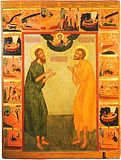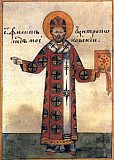

| Previous day | Next day |
| Old Style
July 3
|
Friday |
New Style
July 16
|
|
4th Week after Pentecost.
Tone 2.
Fast Day. |
Wine and oil allowed.
|
![]() Martyr Hyacinth of Caesarea in Cappadocia (108).
Martyr Hyacinth of Caesarea in Cappadocia (108). ![]() Second translation of the relics of Hieromartyr Philip, metropolitan of Moscow and all Russia (1652).
Second translation of the relics of Hieromartyr Philip, metropolitan of Moscow and all Russia (1652).
Martyrs Diomedes, Eulampius, Asclepiodotus, and Golinduc (2nd c.). Martyrs Mocius and Mark (4th c.). St. Alexander, founder of the Monastery of the Unsleeping Ones, Constantinople (ca. 430). St. Anatolius, patriarch of Constantinople (458). St. Anatolius, recluse, of the Near Caves in Kiev (12th c.) and St. Anatolius (another), recluse, of the Far Caves in Kiev (13th c.). Repose of St. Basil, bishop of Ryazan (1295). Sts. Basil and Constantine, princes of Yaroslavl (13th c.). Sts. John and Longinus of Yarenga, monks of Solovki (1561). Blessed John of Moscow, fool-for-Christ (1589). St. Nicodemus of Khozyuga, monk of Kozhaezersk Monastery (1640). St. Basil, archbishop of Novgorod (1352). Blessed Michael, Herodion, Basil, and Thomas, fools-for-Christ, of Solvychegodsk (17th c.).
New Hieromartyr Anthony (Bystrov), archbishop of Arkhangelsk and Kholmogorsk (1931).
“Milk-Giver” Icon of the Most Holy Theotokos of Hilandar, Mt. Athos.
St. Anatolius, bishop of Laodicea, and his successor, St. Eusebius (3rd c.). St. Germanus, bishop of the Isle of Man and enlightener of Peel, nephew of St. Patrick of Ireland (474). St. Isaiah the Solitary, of Scetis and Palestine (ca. 489). St. Symeon the Stylite (the third), of Cilicia (6th c.). St. George the Godbearer, of the Black Mountain, teacher of St. George of Mt. Athos (1068). St. Joachim, monk, of Notena in Achaia (17th c.). New Monk-martyr Gerasimus the New, of Carpenision, at Constantinople (1812). Martyrs Theodotus and Theodota, martyred with St. Hyacinth at Caesarea in Cappadocia (108).
Repose of Nun Euphrosyne “the Unknown,” of Kolyupanovo (Aleksin) (1855).
Thoughts for Each Day of the Year
According to the Daily Church Readings from the Word of God
By St. Theophan the Recluse

Friday. [Rom. 11:25-36; Matt. 12:1-8]
If ye had known what this meaneth, I will have mercy, and not sacrifice, ye would not have condemned the guiltless. Thus, in order to be saved from the sin of condemnation, we must obtain a merciful heart. A merciful heart not only does not condemn a seeming infringement of the law, but neither will it condemn an obvious one. Instead of judgment it feels pity, and would sooner weep than reproach. Truly the sin of condemnation is the fruit of an unmerciful, malicious heart that takes delight in debasing its neighbor, in blackening its neighbor’s name, in trampling his honor underfoot. This is a murderous affair, and is done in the spirit of the one who is a murderer from the beginning [John 8:44]. Here there occurs much slander as well, which comes from the same source—for that is what the devil is, a slanderer, spreading slanderousness everywhere. Hurry to arouse pity in yourself every time the evil urge to condemn comes over you. Then turn in prayer to the Lord with a compassionate heart, that He might have mercy upon all of us, not only upon the one whom we wanted to condemn, but upon us as well—perhaps even more so upon us—and the evil urge will die.
Articles
 Martyr MociusThe Holy Martyrs Mocius and Mark were arrested as Christians and brought to trial by the governor Maximian. |
 Martyr MarkThe Holy Martyrs Mocius and Mark were arrested as Christians and brought to trial by the governor Maximian. |
 St Basil the Bishop of Ryazan |
 Right-believing Prince Basil of Yaroslavl |
 Right-believing Prince Constantine of YaroslavlIn their youth they lost their father, Vsevolod, who fell in battle with the Tatars (Mongols). St Basil, the elder brother, succeeded to the throne. |
 Venerable Nicodemus the Abbot of Kozhe Lake |
 St George the God-BearerSaint George the God-bearer and Recluse labored in the Black Mountains near Antioch during a time when the churches and monasteries there flourished. |










